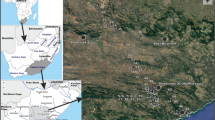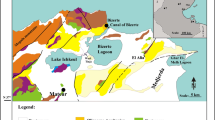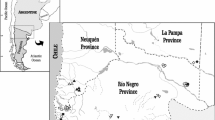Abstract
The modern ostracode distribution in lakes of the north-central United States shows how ostracode abundances are related to concentrations of major ions such as calcium, sulfate, and bicarbonate. These relationships are quantified for species living in lakes that range from fresh water (200 μS cm-1) to saline water (17 000 μS cm-1). Lakes located in the Minnesota forests have different ostracode assemblages and different water chemistry than lakes located on the prairie of North Dakota and South Dakota. These differences are attributed to differences in precipitation and rock-water interactions. Multivariate analyses of the ostracode and water chemistry data set indicate that different ostracode species are associated with different water types. For example, Limnocythere sappaensis and Heterocypris glaucus are found in bicarbonate-enriched sulfate-dominated waters, whereas Limnocythere staplini is found in bicarbonate-depleted sulfate-dominated waters. Candona ohioensis and Limnocythere itasca are found in fresh water, and Candona rawsoni is eurytopic and found in both bicarbonate-enriched and bicarbonate-depleted sulfate-dominated waters. Ostracodes can be used to identify changes in both ionic composition (solutes) and ionic concentration.
Similar content being viewed by others
References
Bartlein, P., T. WebbIII & E. Fleri, 1984. Holocene climatic change in the northern Midwest: pollen-derived estimates. Quat. Res. 22: 361–374.
Brugam, R. B., 1983. The relation between fossil diatom assemblages and limnological conditions. Hydrobiologia 98: 223–235.
Carbonel, P. & J. Peypouquet, 1983. Ostracoda as indicators of ionic concentrations and dynamic variations: methodology (Lake Bogoria, Kenya). In R. Maddocks (ed.), Applications of Ostracoda. Dept. Geosciences, Univ. Houston, Houston, Texas: 264–276.
Chivas, A. R., P.De Deckker & J. Shelley, 1986. Magnesium content of nonmarine ostracode shells: a new paleosalinometer and paleothermometer. Paleogeogr., Paleoclim., Paleoecol. 54: 43–61.
Davis, J. C., 1986. Statistics and data analysis in geology. J. Wiley & Sons, N.Y.: 574–579.
Delorme, L. D., 1969. Ostracodes as Quaternary paleoecological indicators. Can. J. Earth Sci. 6: 1471–1476.
Delorme, L. D., 1970a. Freshwater ostracodes of Canada, part II: subfamily Cypridopsinae and Herpetocypridinae, and family Cyclocyprididae. Can. J. Zool. 48: 253–266.
Delorme, L. D., 1970b. Freshwater ostracodes of Canada, part III: family Candonidae. Can. J. Zool. 48: 1099–1127.
Delorme, L. D., 1970c. Freshwater ostracodes of Canada, part IV: families Ilyocyprididae, Notodromadidae, Darwinulidae, Cytherideidae, and Entocytheridae. Can. J. Zool. 48: 1251–1259.
Delorme, L. D., 1971. Freshwater ostracodes of Canada, part V: families Limnocytheridae, Loxoconchidae. Can. J. Zool. 49: 43–64.
Delorme, L. D., 1989. Methods in Quaternary ecology no. 7: freshwater ostracodes. Geosci. Canada 16: 85–90.
Delorme, L. D., S. C. Zoltai & L. L. Kalas, 1977. Freshwater shelled invertebrate indicators of paleoclimate in northwestern Canada during late glacial times. Can. J. Earth Sci. 14: 2029–2046.
Engstrom, D. & S. Nelson, 1991. Paleosalinity from trace metals in fossil ostracodes compared with observational records at Devils Lake, North Dakota, USA Palaeogeogr., Palaeoclim., Palaeoecol. 83: 295–312.
Eugster, H. P. & B. F. Jones, 1979. Behavior of major solutes during closed-basin brine evolution. Am. J. Sci. 279: 609–631.
Forester, R., 1983. Relationship of two lacustrine ostracode species to solute composition and salinity: implications for paleohydrochemistry. Geology 11: 435–538.
Forester, R., 1987. Late Quaternary paleoclimate records from lacustrine ostracodes. In W. Ruddiman and H. E. Wright (eds.), North America and adjacent oceans during the last deglaciation, The Geology of North America K-3, Geological Soc. America, Boulder, Colorado: 261–276.
Forester, R., 1988. Nonmarine calcareous microfossil sample preparation and data aquisition procedures. US Geological Survey Technical Procedure HP-78 R 1: 1–9.
Forester, R. & E. Brouwers, 1985. Hydrochemical parameters governing the occurrence of estuarine and marginal estuarine ostracodes: an example of south-central Alaska. J. Paleontol. 59: 344–369.
Forester, R., L. D. Delorme & J. P. Bradbury, 1987. Mid-Holocene climate in northern Minnesota. Quat. Res. 28: 263–273.
Gauch, H. G.Jr., 1982. Multivariate Analysis in Community Ecology, Cambridge Univ. Press, Cambridge: 152–160.
Goldman, C. & A. Horne, 1983. Limnology, McGraw-Hill Pub., New York: 221–246.
Gorham, E., W. Dean & J. Sanger, 1982. The chemical composition of lakes in the north-central United States. US Geological Survey Open File Report 82–149, Dept. of the Interior, Washington, D.C.: 1–65.
Hem, J. D., 1989. Study and interpretation of the chemical characteristics of natural water. US Geological Survey Water Supply Paper 2254, 3rd edition, Dept. of the Interior, Washington, D.C., 263 p.
Imbrie, J. & N. Kipp, 1971. A new micropaleontological method for paleoclimatology: application to a Late Pleistocene Caribbean core. In K. Turekian (ed.), The Late Cenozoic Glacial Ages. Yale Univ. Press, New Haven, Conn.: 71–181.
Kelts, K. & K. Hsu, 1978. Freshwater carbonate sedimentation. In A. Lerman (ed.), Lakes: Chemistry, Geology, and Physics. Springer-Verlag, New York: 295–324.
Lister, G., 1988. A 15 000 year isotope record from Lake Zurich of deglaciation and climate change in Switzerland. Quat. Res. 29: 129–141.
Mackereth, F. J. H., J. Heron & J. F. Talling, 1978. Water Analysis: Some Revised Methods for Limnologists, Freshwater Biological Association pub. 36, Cumbria, England: 35–42.
Smith, A. J., 1987. The taxonomy and paleoecology of the Holocene freshwater Ostracoda of Pickerel Lake, South Dakota. M.Sc. Thesis, University of Delaware.
Smith, A. J., 1991. Lacustrine Ostracodes as Paleohydrochemical Indicators in Holocene Lake Records of the North-Central United States, Ph.D. Dissertation, Brown University.
Smith, A. J., L. D. Delorme & R. M. Forester, 1992. A lake's solute history from ostracodes: comparison of methods. In Y. Kharaka & A. Maest (eds.), Water-Rock Interaction, 1. Balkema, Rotterdam: 677–680.
ter Braak, C. J. F., 1989. CANOCO-an extension of DECORANA to analyze species-environment relationships. Hydrobiologia 184: 169–170.
Webb, T.III, P. Bartlein & J. Kutzbach, 1987. Climatic change in eastern North America during the past 18 000 years; comparisons of pollen data with model results. In W. Ruddiman & H. E. Wright, (eds.), North America and adjacent oceans during the last deglaciation. The Geology of North America K-3. Geological Soc. of America, Boulder, Colorado: 447–462.
Winter, T. & M-K. Woo, 1990. Hydrology of lakes and wetlands. In M. Wolman and H. Riggs (eds.), Surface water hydrology, The Geology of North America O-1. Geological Soc. America, Boulder, Colorado: 159–188.
Wright, H. E., 1980. Cores of soft lake sediments. Boreas 9: 107–114.
Author information
Authors and Affiliations
Rights and permissions
About this article
Cite this article
Smith, A.J. Lacustrine ostracodes as hydrochemical indicators in lakes of the north-central United States. J Paleolimnol 8, 121–134 (1993). https://doi.org/10.1007/BF00119785
Accepted:
Issue Date:
DOI: https://doi.org/10.1007/BF00119785




